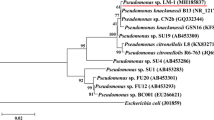Abstract
A bacterial isolate, TZ-1, was isolated from contaminated sediment near electronic waste dismantling workshops, Taizhou, China that degraded 2,2′,4,4′-tetrabrominated diphenyl ether (BDE-47). The isolate was identified as Pseudomonas putida sp. with respect to its morphology, biochemical characteristics and 16SrDNA sequence analysis. TZ-1 can use BDE-47 as the sole carbon and energy source for growth in mineral salt medium. The isolate degraded BDE-47 up to 49.96 % of the initially applied concentration of 50 μg L−1 after 7 days of incubation at 150 rpm, 30°C. Static conditions with pH 6.5 and temperature 30°C were considered to be optimum for BDE-47 biodegradation. Addition of co-substrates promoted cell growth, but decreased the degradation rate for BDE-47.



Similar content being viewed by others
References
Cai Z, Jiang G (2006) Determination of polybrominated diphenyl ethers in soil from e-waste recycling site. Talanta 70:88–90
Connell DW (2005) Basic concepts of environmental chemistry, 2nd edn. Taylor and Francis Group, Boca Raton
de Wit CA (2002) An overview of brominated flame retardants in the environment. Chemosphere 46:583–624
Deng D, Guo J, Sun G, Chen X, Qiu M, Xu M (2011) Aerobic debromination of deca-BDE: isolation and characterization of an indigenous isolate from a PBDE contaminated sediment. Int Biodeterior Biodegradation 65:465–469
Gibson DT, CrudeN DL, Haddock JD, Zylstra GJ, Brand JM (1993) Oxidation of polychlorinated-biphenyls by pseudomonas sp strain-LB400 and pseudomonas-pseudoalcaligenes kf707. J Bacteriol 175:6735
Hadibarata T, Kristanti RA (2012) Fate and cometabolic degradation of benzo[a]pyrene by white-rot fungus Armillaria sp. F022. Bioresour Technol 107:314–318
Holt JG, Krieg NR, Sneathm PH, Staley JT, Williams ST (1994) Bergey’s manual of determinative bacteriology, 9th edn. Willian and Wilkins, Baltimore, MD
Jin J, Wang Y, Liu W, Yang C, Hu J, Cui J (2011) Polybrominated diphenyl ethers in atmosphere and soil of a production area in China: levels and partitioning. J Environ Sci China 23:427–433
Jin Q, Hu Z, Jin Z, Qiu L, Zhong W, Pan Z (2012) Biodegradation of aniline in an alkaline environment by a novel strain of the halophilic bacterium, Dietzia natronolimnaea JQ-AN. Bioresour Technol 117:148–154
Key BD, Howell RD, Criddle CS (1998) Defluorination of organofluorine sulfur compounds by Pseudomonas sp. strain D2. Environ Sci Technol 32:2283–2287
Kim Y, Nam I, Murugesan K, Schmidt S, Crowley DE, Chang Y (2007) Biodegradation of diphenyl ether and transformation of selected brominated congeners by Sphingomonas sp PH-07. Appl Microbiol Biotechnol 77:187–194
Leung AOW, Luksemburg WJ, Wong AS, Wong MH (2007) Spatial distribution of polybrominated diphenyl ethers and polychlorinated dibenzo-p-dioxins and dibenzofurans in soil and combusted residue at Guiyu, an electronic waste recycling site in southeast China. Environ Sci Technol 41:2730–2737
Ma J, Qiu X, Zhang J, Duan X, Zhu T (2012) State of polybrominated diphenyl ethers in China: an overview. Chemosphere 88:769–778
Prabhu Y, Phale PS (2003) Biodegradation of phenanthrene by Psuedomonas sp strain PP2: novel metabolic pathway, role of biosurfactant and cell surface hydrophobicity in hydrocarbon assimilation. Appl Microbiol Biotechnol 61:342–351
Qiu M, Chen X, Deng D, Guo J, Sun G, Mai B, Xu M (2012) Effects of electron donors on anaerobic microbial debromination of polybrominated diphenyl ethers (PBDEs). Biodegradation 23:351–361
Robrock KR, Coelhan M, Sedlak DL, Alvarez-Cohen L (2009) Aerobic biotransformation of polybrominated diphenyl ethers (PBDEs) by bacterial isolates. Environ Sci Technol 43:5705–5711
Sander P, Wittich RM, Fortnagel P, Wilkes H, Francke W (1991) Degradation of 1,2,4-trichlorobenzene and 1,2,4,5-tetrachlorobenzene by pseudomonas strains. Appl Environ Microbiol 57:1430–1440
Somaraja PK, Gayathri D, Ramaiah N (2013) Molecular characterization of 2-chlorobiphenyl degrading Stenotrophomonas maltophilia GS-103. Bull Environ Contam Toxicol 91:148–153
Wang T, Wang Y, Fu J, Wang P, Li Y, Zhang Q, Jiang G (2010) Characteristic accumulation and soil penetration of polychlorinated biphenyls and polybrominated diphenyl ethers in wastewater irrigated farmlands. Chemosphere 81:1045–1051
Wania F, Dugani CB (2003) Assessing the long-range transport potential of polybrominated diphenyl ethers: a comparison of four multimedia models. Environ Toxicol Chem 22:1252–1261
Xie H, Zhu LS, Xu QF, Wang J, Liu W, Jiang JH, Meng Y (2011) Isolation and degradation ability of the DDT-degrading bacterial strain KK. Environ Earth Sci 62:93–99
Yen JH, Liao WC, Chen WC, Wang YS (2009) Interaction of polybrominated diphenyl ethers (PBDEs) with anaerobic mixed bacterial cultures isolated from river sediment. J Hazard Mater 165:518–524
Zhang X, Luo X, Chen S, Wu J, Mai B (2009) Spatial distribution and vertical profile of polybrominated diphenyl ethers, tetrabromobisphenol A, and decabromodiphenylethane in river sediment from an industrialized region of South China. Environ Pollut 157:1917–1923
Zhang SW, Xia XH, Xia N, Wu S, Gao F, Zhou WW (2013) Identification and biodegradation efficiency of a newly isolated 2,2′,4,4′-tetrabromodiphenyl ether (BDE-47) aerobic degrading bacterial strain. Int Biodeterior Biodegradation 76:24–31
Author information
Authors and Affiliations
Corresponding author
Rights and permissions
About this article
Cite this article
Xin, J., Liu, X., Liu, W. et al. Aerobic Transformation of BDE-47 by a Pseudomonas putida sp. Strain TZ-1 Isolated from PBDEs-Contaminated Sediment. Bull Environ Contam Toxicol 93, 483–488 (2014). https://doi.org/10.1007/s00128-014-1306-6
Received:
Accepted:
Published:
Issue Date:
DOI: https://doi.org/10.1007/s00128-014-1306-6




